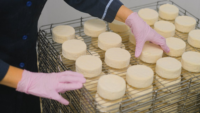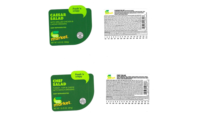The public health significance of Listeria monocytogenes is well known. Listeriosis, the illness caused by L. monocytogenes, has a high fatality rate, ranging from 20-30%.[1] High-risk populations include pregnant women and their unborn fetuses, immuno-compromised individuals, cancer patients and the elderly.[2] The manifestations of listeriosis include septicemia, meningitis, encephalitis and intrauterine or cervical infections in pregnant women, which may result in spontaneous abortions or stillbirths. Gastrointestinal or influenza-like symptoms, such as nausea, vomiting, diarrhea and fever, may precede more serious forms of listeriosis or may be the only expressed symptoms.[2]
L. monocytogenes has been recognized as a hazard reasonably likely to occur in cooked, ready-to-eat (RTE) meat and poultry products. Numerous foodborne outbreaks have been linked to the consumption of RTE meats, including hot dogs and deli meats. These products are considered high risk due to the ability of L. monocytogenes to multiply at refrigeration temperatures, coupled with the high fatality rate of listeriosis. The U.S. Department of Agriculture’s Food Safety and Inspection Service (FSIS) released an interim final rule in 2003 to address public health concerns with regard to L. monocytogenes in these products and in processing environments. FSIS used a science-based approach in developing these regulations to address the most at-risk products and processors. Each processor of RTE meat and poultry products could choose one of three alternative programs for the control of L. monocytogenes in their products:[3]
Alternative 1: A post-lethality treatment that reduces or eliminates L. monocytogenes AND an antimicrobial agent or process that suppresses or limits its growth throughout its shelf-life
Alternative 2: A post-lethality treatment that reduces or eliminates L. monocytogenes OR an antimicrobial agent or process that suppresses or limits its growth throughout its shelf-life
Alternative 3: Sanitation control measures, which may be incorporated in the establishment’s Hazard Analysis and Critical Control Points plan, Sanitation Standard Operating Procedures (SSOPs) or prerequisite programs are the only controls to prevent L. monocytogenes
contamination
For establishments choosing to operate using Alternative 3, consumer protection depends on preventing contamination in those foods in which growth can occur. Intervention strategies and control measures used in these RTE processing environments will be discussed.
Control in the Processing Environment
Processors that rely solely on SSOPs and Good Manufacturing Practices to provide safe, Listeria-free products would be considered Alternative 3 facilities. Manufacturing under Alternative 3 is higher risk and will enable more scrutiny from FSIS inspectors; however, if managed properly, these facilities can provide safe products with an extended shelf-life.
Growth of L. monocytogenes within a niche or harborage site in the post-processing environment is the major concern with regard to Listeria control. Thus, aggressive sanitation and sanitary design of both equipment and facilities are critical to identifying and eliminating niche sites and preventing subsequent product contamination. Cleaning for Listeria control includes breakdown of equipment to cleanable levels so that niche sites can be reached. If the equipment is not easily taken apart, niche sites will not be reached, and product and moisture build-up will occur in these uncleanable harborage sites, leading to microbial growth. The American Meat Institute has developed principles for the sanitary design of facilities and equipment.[4] The principles for sanitary design of facilities focus on three broad themes: provide zones of control, keep it cold and control moisture and design to facilitate sanitation. The 10 principles of sanitary design of equipment include the following:[4]
• Cleanable to a microbiological level
• Made of compatible materials
• Accessible for inspection, maintenance, cleaning and sanitation
• No product or liquid collection
• Hollow areas hermetically sealed
• No niches
• Sanitary operational performance
• Hygienic design of maintenance enclosures
• Hygienic compatibility with other plant systems
• Validated cleaning and sanitizing protocols
Once the sanitation and prerequisite programs have been put into place and all personnel are trained, the processing environment must be monitored to verify that the programs are working and that harborage sites have not developed. Alternative 3 facilities are required to have an environmental monitoring program in place that includes product contact testing in the post-lethality processing areas to ensure that surfaces are sanitary and free of L. monocytogenes or its indicator organisms.[3] The monitoring program must include details on the frequency of testing, size and location of sample sites and should include an explanation of why the testing frequency is adequate to ensure that effective control is maintained.
The establishment should also identify the hold-and-test procedures following a positive result on a product contact surface.[3] An effective monitoring program will identify the source of contamination, eliminate the microorganism from the environment and prevent future contamination by ongoing testing of indicator sites. These indicator sites are non-product contact sites that “indicate” the presence of the microorganism in the processing environment or ancillary areas.
The “zone” concept is widely used in RTE meat and poultry plants for environmental monitoring programs; plant operations are divided into zones based on level of risk. Zone 1 represents product contact surfaces, the highest level of risk. Zone 2 sites are non-product contact sites that are directly adjacent to product contact surfaces and can include control buttons, equipment framework and mechanics’ tools. Zone 3 sites are within the post-processing areas and include floors, walls, drains, floor mats, forklifts, pallets and air handling units. Zone 4 sites are not in the post-processing areas, but if unchecked, can lead to cross-contamination of Zones 1, 2 and 3. Zone 4 areas include hallways, loading docks, warehouses, coolers, bathrooms, locker rooms and break rooms.
For a processing facility that is not in control, sampling and testing efforts should be focused on Zone 1 sites to understand the prevalence and to identify and eliminate growth niches. For a processing facility that is in control, sampling and testing focus can move into Zones 2, 3 and 4. Successful processors focus on prevention of contamination by focusing their sampling efforts on indicator sites and then reacting to all positive results, at both product contact and indicator sites, quickly and effectively. Note that Zone 1, or product contact testing, is a requirement for Alternative 3 processors and must be included in the sampling program.
The environmental sampling program is critical to preventing and controlling Listeria in RTE meat and poultry environments. The goal of this program is to find the microorganism. However, ongoing monitoring of the environment would be useless if no efforts were in place to fix the problem once identified. Every successful sampling program must include a corrective action plan to define how the processor will respond to a positive finding. These corrective actions should identify and control the source of the contamination, thereby preventing future contamination.
Intervention Strategies
RTE meat and poultry processors rely on numerous interventions for controlling the transfer, development of niches, and growth of Listeria in the manufacturing environment. Industry sharing of best practices and lessons learned has been a key component of the success of this food industry segment. Meat processors have agreed that food safety information should be shared on a non-competitive basis and are willing to share best practices for strategies that work in their facilities through Listeria workshops. Although many of these strategies have not been validated in a laboratory setting, processors routinely utilize them and have demonstrated success with regard to Listeria control.
Successful processors have learned that controlling Listeria on floors will reduce the incidence of contamination of product contact surfaces and that this can be accomplished with adequate cleaning and sanitation. Scrubbing floors with caustic, rinsing and then sanitizing with a high concentration of sanitizer (800–1,000 ppm quaternary ammonium compound as described by Tompkin), is an effective way to do so.[5] Drying floors completely before start up and keeping them dry throughout production is essential. Additionally, the use of various sanitizers in high traffic areas, or areas with a high level of moisture, can improve control. The use of powdered quaternary ammonium compounds has been shared as a best practice that RTE meat processors have implemented and demonstrated successfully in control of Listeria.
Other strategies for control of Listeria on floors include the use of door foamers, which spray a foam-based sanitizer upon entrance into an RTE area, and sole scrubbers, which combine mechanical action to remove debris from footwear as well as a sanitizer to inactivate microorganisms. These interventions provide control, as demonstrated by plant environmental data. Further research to validate the effectiveness of these systems will aid the industry in defining the optimum usage levels and conditions for use.
Another strategy used by successful processors is the scheduled cleaning of equipment, thus preventing niche development. This can include cooking or steaming equipment that is difficult to clean or is not hygienically designed. Equipment that is small enough can be placed directly in the smokehouse or oven. Some equipment, such as packaging machines, may be too large to move into the smokehouse. A best practice that has a demonstrated record of success is steaming the entire packaging line. This technique has proven effective for a packaging line that had an ongoing problem with Listeria contamination, but a niche could not be identified. Scheduling this equipment cooking process into the preventative maintenance schedule of the processing facility can prevent the development of a harborage site.
Maintenance tools, if not controlled, can be problematic with regard to contamination and transfer of microorganisms of concern. Maintenance personnel and tools should be dedicated to raw or cooked areas within the processing facility. Hand-held tools should be cleaned and sanitized daily and stored in a sanitary manner. Some processors have reported success with scheduled “cooking” of maintenance tools, which is built into the preventative maintenance schedule.
Brine chill systems are used for chilling certain deli meats and link products. These systems, although high in salt concentration, can easily become contaminated with Listeria and can serve as potential harborage sources that can affect multiple lines of packaged product. Brine chill systems pose a significant risk as a source of bacterial contamination, and all products produced with these systems are vulnerable to cross-contamination. The use of citric acid to lower the pH of these brines has proven successful at inactivating L. monocytogenes and preventing cross-contamination. Acidifying brine chill systems with citric acid is an effective treatment in controlling Listeria in these systems, as long as the pH remains in the 3.0–3.5 range (unpublished data). The pH should be monitored throughout the production day to verify the pH is in the appropriate range.
The RTE meat and poultry industry has come a long way since L. monocytogenes was first recognized as a foodborne pathogen. Many of the lessons learned by processors have come the hard way, and they have the scars to prove it. The willingness within this industry segment to share their stories and case studies, lessons learned and best practices developed is a true example of collaboration.
Robin M. Kalinowski, M.S., is a Research Project Manager at the Silliker, Inc. Food Science Center, South Holland, IL. She possesses over 20 years of food industry experience and can be reached at info@silliker.com.
References
1. www.fda.gov/food/guidancecomplianceregulatoryinformation/guidancedocuments/foodprocessinghaccp/ucm073110.htm.
2. www.fda.gov/Food/FoodSafety/FoodborneIllness/FoodborneIllnessFoodbornePathogensNaturalToxins/BadBugBook/ucm070064.htm.
3. www.fsis.usda.gov/OPPDE/rdad/FRPubs/97-013F/ Lm_Rule_Compliance_Guidelines_May_2006.pdf.
4. www.meatami.com/FoodSecurity/11PrinciplesHandout.ppt.
5. Tompkin, R.B. 2002. Control of Listeria monocytogenes in the food-processing environment. J Food Prot 65:709-725.



